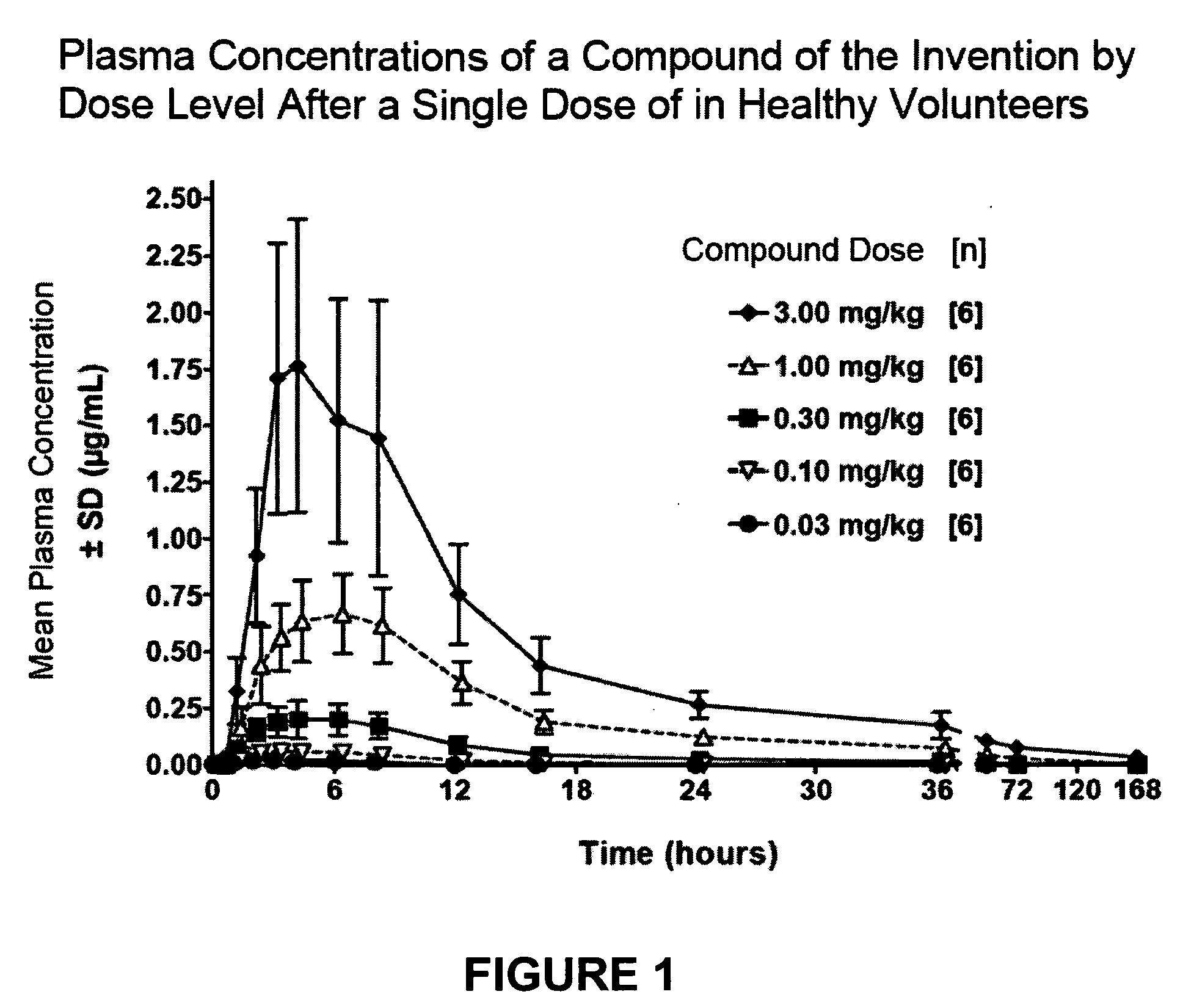Administration of carboline derivatives useful in the treatment of cancer and other diseases
a technology of carboline derivatives and cancer, applied in the direction of phosphorous compound active ingredients, metabolism disorders, antibody medical ingredients, etc., can solve the problems of high cost, inability to produce multiple injections, and inability to achieve multiple injections, so as to slow the tumorigenesis of a solid tumor and reduce plasma and solid tumor vegf levels
- Summary
- Abstract
- Description
- Claims
- Application Information
AI Technical Summary
Benefits of technology
Problems solved by technology
Method used
Image
Examples
example 1
Plasma Concentrations of Orally Administered Compounds and the Effect of Food
[0327]Groups of normal healthy human volunteers (six per group) are administered a single oral dose (0.03, 0.10, 0.30, 1.00, or 3.00 mg / kg) of a compound of the invention. At the indicated times after administration samples of venous blood are withdrawn from the volunteers and the plasma concentration of the compound in each sample is determined using liquid chromatography and tandem mass spectroscopy (LC-MS / MS). Mean plasma concentrations are plotted versus time along with the standard deviation of the values. See FIG. 1. Pharmacokinetic parameters, including the maximum concentration (Cmax); the time of maximum concentration (Tmax) and the area under the curve (AUC) for a given time period (e.g., the AUC over the first 24 hours AUC0-24) are calculated from the data. Error ranges presented are given as ±the standard deviation.
example 2
[0328]In order to evaluate the effect of food on the plasma concentration of orally administered compounds of the invention a group of twelve healthy human volunteers, six male and six female, are employed. The volunteers are randomly assigned to one of two groups, a fed group and a fasted group for the first week of the evaluation. Immediately prior to compound administration (1 mg / kg) the fed group is given a high-fat high-calorie meal, whereas the fasted group did not receive a meal prior to administration of the compound. At multiple times after compound administration, samples of venous blood are withdrawn from the volunteers and the plasma concentration of the compound in each sample is determined using liquid chromatography and tandem mass spectroscopy (LC-MS / MS). In the second week of the experiment, the groups are crossed over with the fed group becoming the fasted group an the fasted group becomes the fed group. The data are shown in FIG. 2, mean plasma concentrations are ...
example 3
Plasma Concentrations Over Multiple Days with Dosing Twice Daily
Part A—Studies in Mice
[0329]Compounds of the invention are tested in a mouse fibrosarcoma model. Briefly, nude mice bearing HT1080 fibrosarcoma xenografts are treated with a compound of the invention the range of 1 to 10 mg / kg (mg of compound / kg of body weight) given once per day or twice per day for 18 days. After 18 days of treatment tumor and plasma VEGF levels are measured by ELISA. Treatment either once or twice per day with a compound of the present invention over the range of 1-10 mg / kg reduces mean tumor VEGF concentrations greater than 85% and plasma VEGF levels 95% or greater relative to control values.
Part B—Canine Studies
[0330]Four male beagles are given escalating doses of a compound of the invention. On days 1, 4, 8, and 12 of the study, each animal is given a single dose of vehicle (n=1) and test compound at 30 mg / kg, 60 mg / kg or 120 mg / kg (n=1 each), respectively. Compounds are administered orally in a l...
PUM
| Property | Measurement | Unit |
|---|---|---|
| Fraction | aaaaa | aaaaa |
| Fraction | aaaaa | aaaaa |
| Fraction | aaaaa | aaaaa |
Abstract
Description
Claims
Application Information
 Login to View More
Login to View More - R&D
- Intellectual Property
- Life Sciences
- Materials
- Tech Scout
- Unparalleled Data Quality
- Higher Quality Content
- 60% Fewer Hallucinations
Browse by: Latest US Patents, China's latest patents, Technical Efficacy Thesaurus, Application Domain, Technology Topic, Popular Technical Reports.
© 2025 PatSnap. All rights reserved.Legal|Privacy policy|Modern Slavery Act Transparency Statement|Sitemap|About US| Contact US: help@patsnap.com



